 Building a Wooden Windmill
Building a Wooden Windmill Building a Wooden Windmill
Building a Wooden Windmill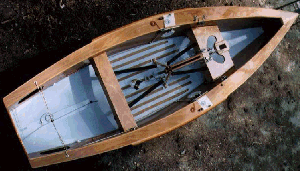
The plans and specifications allow the builder a great deal of latitude. The Windmill is a plywood boat, but there are many types of plywood. Marine grade plywood may be used, but to make the boat more attractive occume, (Dutch Mahogany), is favored by many builders. Varnished occume is magnificent in appearance! 1/4" sheets may be used throughout; however the tolerances on the specifications allow 3/16" (and even 1/8") to be used in some areas to save weight. The result is still a very strong and rigid hull. Four plywood sections can plank the entire boat.
If the builder chooses, the thwarts, deck rails and blades may be constructed of alternating light and dark edge glued wood strips for a truly custom look. In short, all Windmills are alike; yet everyone is unique.
Hull construction time averages around 200 hours. The time required to finish the hull with paint or varnish is highly variable. Rigging will take another 40 hours. The total costs average around $2500, including sails and trailer and using the best grade materials and hardware.
The Plans Package makes suggestions and provides sketches on various sail controls; but the final choice is the owners. The Windmill is governed by a set of specifications with construction tolerances which are reasonable, but finite. A completed boat, must pass measurement at over 50 points before she can be certified as a Windmill. This ensures that the most recent one built is in all respects the same as the first, thus not only protecting the builder's investment in time and money, but guaranteeing that any new ideas introduced will not give new boats an advantage over older Windmills.
The following is a excerpt from the How To Build a Windmill manual by Bill Baker of San Antonio, Texas summing up his results with the construction of #4810, his second 'Mill.
How long should all this work take? From receipt of the Plan package in December, I was sailing on the following Memorial Day. I did all the work on weekends and evenings, and I had lots of business travel in my engineering job that eliminated many evenings. Cold weather caused some delays, because the epoxy resins will not set when the temperature drops below 45 degrees Fahrenheit. If you plan ahead and order everything in advance, you could probably build the boat in your spare time in two months. Much of my scheduling was fixed by the family budget.With average carpentry skills and average patience, you should be able to do at least as well as I did. The discussion of construction techniques in the manual and in the Gougeon Brothers' book should make the project go very smoothly. The epoxy saturation, epoxy gluing, blind nailing methods, and scarfing procedures described by the Gougeons all work admirably and a beautiful and seaworthy boat results.
A wooden Windmill built like #4810 is competitive with fiberglass Windmills. She is at minimum weight, she is stiffer and the finish can be better than a fiberglass boat. A real plus is that a natural finish wooden boat is very handsome, and will get many admiring looks and feels.
The Windmill Plans Package can be ordered from the Windmill Class Association Secretary (See contact on the home page).
The Windmill Plans Package is a complete source of information on how to construct a first class boat, all you add is your time, skill, love and a portion of what you have left after taxes.
The Plans Package includes:
The How-To manual is written with the amateur builder in mind. If you have built a boat before, you will skim through the manual. But, if this is your first time, you will welcome the carefully thought out advise - advise that was written in response to specific questions. All that is required to build a Windmill is studying the blueprints and reading the manual, before you start making sawdust.
Backing up the package are hundreds of Windmillers who have built the boat before you and who are willing to share their experience with you.
The Windmill is one of the very few one-design boats that can be built by amateurs from plywood and still be competitive on the race course with professionally built fiberglass boats. If you want a day sailor, she is also a good choice; but be forewarned she is a high performance boat and is not suitable for everyone or for all purposes.
A handbook on the alternative construction method, is described in
Building The
Composite Wood/Epoxy Windmill Sailboat
is available direct from the author, Tom Lathrop. The handbook
has photos showing the stages of female mold and hull
construction. Full-size mylar templates are also available. This
handbook is a supplement to the Plans Package available from
the Class Association. To order the composite handbook or the
templates, write or call Tom Lathrop, PO Box 752, Oriental, NC
28571 (252) 249-2646 or send email to
Harbinger.
Pictures of wooden Windmills
(click on thumbnail for enlargement)
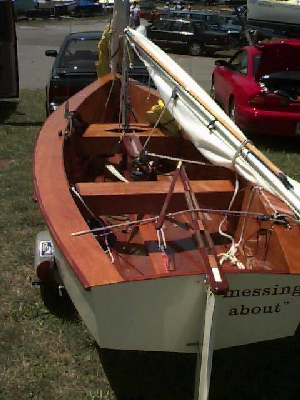 Jim Waller's homemade Messing About. This helps explain the fuss over woodies.
Jim Waller's homemade Messing About. This helps explain the fuss over woodies.
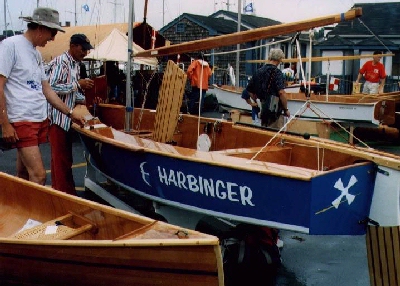 A nice shot of the first composite construction boat Harbinger at a wooden boat show up north. What a beauty.
A nice shot of the first composite construction boat Harbinger at a wooden boat show up north. What a beauty.
 The Adams' notorius Hell Bitch, an older woodie that just keeps on kickin' butt.
The Adams' notorius Hell Bitch, an older woodie that just keeps on kickin' butt.
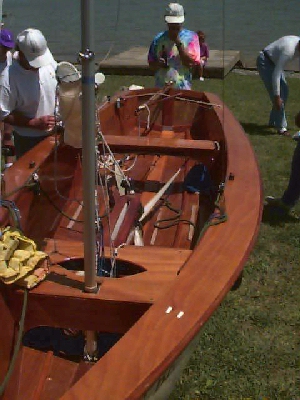 Another view of the traditionally constructed Messing About.
Another view of the traditionally constructed Messing About.
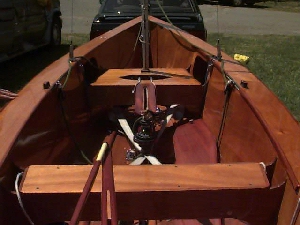 Take a closer look at Messing About.
Take a closer look at Messing About.
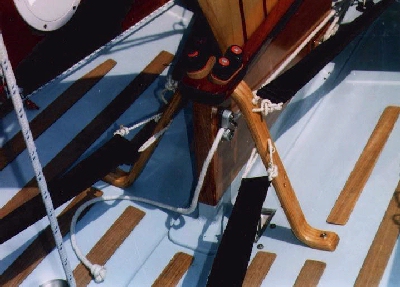 Check out this close-up of the fine craftsmanship of Harbinger.
Check out this close-up of the fine craftsmanship of Harbinger.
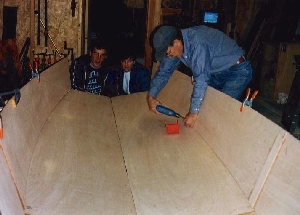 This shows the frame mold for the composite construction technique.
This shows the frame mold for the composite construction technique.
 Jouster #5102 Built by Bill Lewis of Nashville. Note non skid.
Jouster #5102 Built by Bill Lewis of Nashville. Note non skid.
 Jousterrigged for trailering
Jousterrigged for trailering
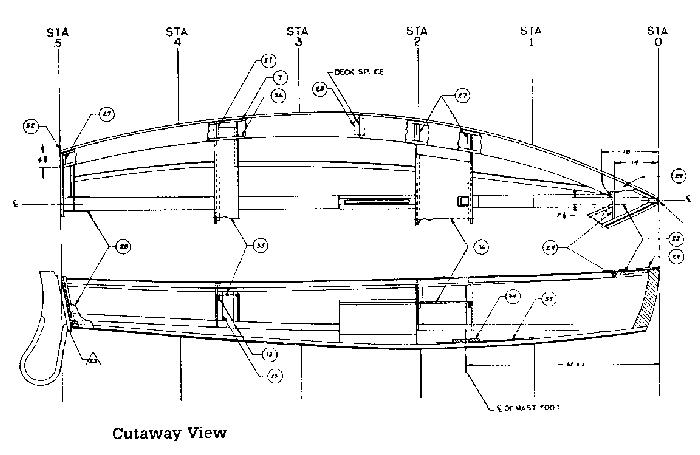
This shows a cutaway sketch of a wooden 'Mill.
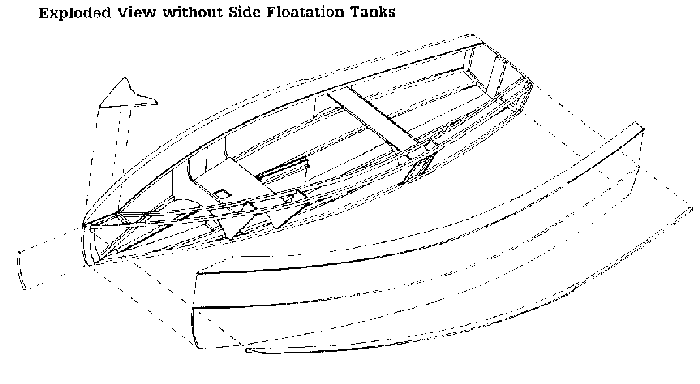
This shows a exploded sketch of a wooden 'Mill.